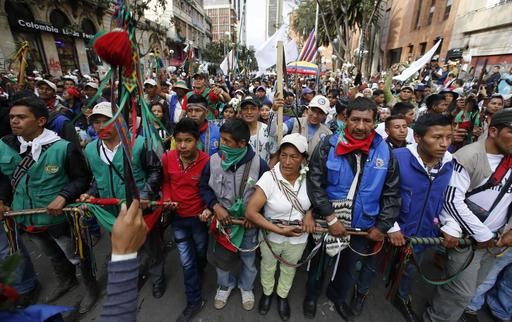Leaders from around the world rejoiced at the deal. US Secretary of State John Kerry called it “transformational moment for the Colombian people.” UN Secretary General Ban Ki-Moon hailed the negotiations as “an inspiration for all.” Even Evo Morales and Nicolás Maduro, the left-wing leaders of Bolivia and Venezuela who rarely find themselves on the same page as the United States, praised the agreement. International support for the deal came to a peak with that year’s Nobel Peace Prize, awarded to President Santos in recognition of his efforts toward “peace and reconciliation.”
Among the people of Colombia, however, the deal wasn’t met with such universal acclaim. The October 2 referendum, in which Santos had predicted an easy win for the peace deal, narrowly rejected the agreement in a 50.2% to 49.7% vote. Santos renegotiated the agreement with FARC during the month following the referendum, but had learned his lesson. This time he sent the deal to a Congress for approval, eschewing a public vote. Since the referendum, the President’s approval rating has fallen to 24% according to Gallup, a far cry from his 82% approval at the outset of his administration. What explains the gap between international support for the deal and the distrust within Colombia?

There are two sides in the peace vs. justice debate. A view often held by human rights activists is that justice is a condition for, rather than an obstacle to, long-term peace. Richard Dicker of Human Rights Watch notes that if those who have committed war crimes and human rights abuses aren’t held accountable, peace will not be “sustainable.” The deal will fail to address the underlying problem of impunity, and future violators of human rights will commit crimes without fear of punishment. The opposing view, more often proposed by diplomats and military officials, proposes that an attempt at accountability can backfire and end up prolonging conflict. Jack Snyder of Columbia University and Leslie Vinjamuri of Georgetown University argues that “justice does not lead; it follows.” Amnesty and other strategies may be important steps in achieving an end to conflict, and only after the end of a conflict can institutions become strong enough to hold violators of human rights accountable.
In cases like the Colombian government’s negotiations with FARC, achieving a balance between peace and justice is no easy task. David Tolbert of the International Center for Transitional Justice notes that whenever we evaluate whether to pursue peace or justice in a country emerging from conflict, we should look at the local circumstances and the issues that matter in victims’ daily lives. To understand the divide between those who rejected the peace deal and those who favored it, we have to understand the history of the conflict.
The Revolutionary Armed Forces of Colombia, known by its Spanish acronym FARC, formed in 1964 under the leadership of Colombian Communist Party member Manuel Marulanda. FARC’s initial goal was an ideological one, providing services to Marxist communes in southern Colombia, defending their territory against government forces, and calling for less U.S. involvement at the height of the Cold War. In more recent years, FARC members have expressed a variety of motivations for their fight against Bogotá. While some maintain ideological opposition to the Washington-allied central government, a 2003 UN report most fighters join the organization seeking belonging, escape from poverty, or even a “spirit of adventure.” Still others join out of revenge or because they have had relatives who fought.

The human toll of FARC’s decades-long clash with the Colombian government goes far beyond the harm done to kidnapping victims. Government figures put the death toll of the FARC-Colombia conflict at 220,000, more than many estimates of the number of deaths in the 2003 US War in Iraq. The 6.9 million internally displaced persons in Colombia comprised the greatest number of IDPs worldwide in 2016, surpassing those of Syria and Iraq.
Growing up in a country with so many people displaced, kidnapped, and killed, a peace deal that allows militants to reenter politics with impunity looks less like a black-and-white issue than it does from an outsider’s perspective. Over the next few months, I will use this blog to think about the specifics of the FARC peace deal, the reactions of the Colombian people and global stakeholders, and the implications for other conflicts. Colombia’s transition to peace is an enormously important event for those who have been affected by the FARC conflict, but its significance goes beyond borders. For other countries resolving civil conflict, Colombia provides a framework for balancing peace and justice.








